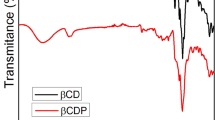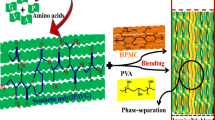Abstract
The aim of this work was to provide an understanding of the interaction occurring between ketoprofen and poly(lacticco-glycodic acid) (PLGA) that leads to polymer plasticization. Experimental glass transition temperature (Tg) values were fitted with the theoretical ones predicted by the Fox and Gordon-Taylor/Kelley-Bueche equations. PLGA films containing different amounts of ketoprofen (KET) were prepared by solvent casting and characterized by scanning electron microscopy, differential scanning calorimetry, and Fourier transform infrared spectroscopy (FTIR). Differential scanning calorimetry evidenced that KET acted as a plasticizer in a similar biphasic way in both end-capped and uncapped PLGA. At KET contents of 20% to 35%, depending on the investigated polymer, the Tg was around 23°C. Higher KET amounts did not lower further the Tg, and the excess of drug was found to crystallize into the polymeric matrix. Experimental Tg's deviated negatively from the predicted ones probably because of hydrogen bonding. The FTIR spectra of the films, loaded with different amounts of KET, showed a shift to higher wavenumbers for the peaks at 1697 and 1655 cm−1 confirming the presence of some interactions, probably hydrogen bonds between the ketoprofen carboxylic group and the PLGA carbonyl groups along the polymer backbone. The hydrogen bonding between KET and PLGA is probably responsible for KET plasticizing effect. KET behaving as a lubricant may disrupt polymer chain-chain interactions, removing additional barriers to bond rotation and chain mobility.
Similar content being viewed by others
References
DeLuca PP, Mehta RC, Hausberger AG, Thanoo BC. Biodegradable polyesters for drug and polypeptide delivery. In: El-Nokaly MA, Piatt DM, Charpentier BA, eds.Polymeric Drug Delivery Systems. Washington, DC: American Chemical Society; 1993:53–79.
Giovagnoli S, Blasi P, Ricci M, Rossi C. Biodegradable microspheres as carriers for native superoxide dismutase and catalase delivery.AAPS Pharm Sci Tech. 2004;5: Article 51.
Ricci M, Blasi P, Giovagnoli S, Perioli L, Vescovi C, Rossi C. Leucinostatin-A loaded nanospheres: characterization and in vivo toxicity and efficacy evaluation.Int J Pharm. 2004;275:61–72.
Jain RA. The manufacturing techniques of various drug loaded biodegradable poly(lactide-co-glycolide) (PLGA) devices.Biomaterials. 2000;21:2475–2490.
Sperling LH.Introduction to Physical Polymer Science. New York, NY: John Wiley & Sons; 2001.
Okada H, Doken Y, Ogawa Y, Toguchi H. Preparation of three-month injectable microspheres of leuprorelin acetate using biodegradable polymers.Pharm Res. 1994;11:1143–1147.
Selmin F, D'Souza SS, Blasi P, DeLuca PP. Hydrolytic degradation of PLGA microspheres containing a tertiary amine drug substance [abstract].AAPSJ [serial online]. 2004;S1:Abstract R6176.
Ricci M, Blasi P, Giovagnoli S, et al. Ketoprofen controlled release from composite microcapsules for cell encapsulation: Effect on post-transplant acute inflammation.J Control Release. 2005:107:395–407.
Karlsson OJ, Stubbs JM, Karlsson LE, Sundberg DC. Estimating diffusion coefficients for small molecules in polymers and polymer solutions.Polym. 2001;42:4915–4923.
Di Martino P, Joiris E, Gobetto R, Masic A, Palmieri GF, Martelli S. Ketoprofen-poly(vinylpyrrolidone) physical interaction.J Cryst Growth. 2004;265:302–308.
Fernández-Carballido A, Herrero-Vanrell R, Molina-Martinez IT, Pastoriza P. Biodegradable ibuprofen-loaded PLGA microspheres for intraarticular administration effect of labrafil addition on release in vitro.Int J Pharm. 2004;279:33–41.
Kunze C, Freier T, Kramers S, Schmitz KP. Anti-inflammatory prodrugs as plasticizers for biodegradable implant materials based on poly (3-hydroxybutyrate).J Mater Sci. 2002;13:1051–1055.
Wu C, McGinity JW. Non-traditional plasticizations of polymeric films.Int J Pharm. 1999;177:15–27.
Tarvainen M, Sutinen R, Somppi M, Paronen P, Poso A. Predicting plasticization efficiency from three-dimensional molecular structure of a polymers plasticizer.Pharm Res. 2001;18:1760–1766.
Wang Y, Challa P, Epstein DL, Yuan F. Controlled release of ethacrynic acid from poly(lactide-co-glycolide) films for glaucoma treatment.Biomaterials. 2004;25:4279–4285.
Wahab MA, Kim I, Ha C-S. Microstructure and properties of polyimide/poly(vinylsilsesquioxane) hybrid composite films.Polym. 2003;44:4705–4713.
Papkov VS, Nikiforova GG, Nikol'sky VG, Krasotkina IA, Obolonkova ES. Transparent microheterogeneous blends containing a multiblock copolymer and a foreign homopolymers.Polym. 1998;39:631–640.
Feldstein MM, Shandryuk GA, Plate NA. Relation of glass transition temperature to the hydrogen-bonding degree and energy in poly(N-vinyl pyrrolidone) blends with hydroxyl containing-plasticizers. Part 1. Effects of hydroxyl group number in plasticizer molecule.Polym. 2001;42:971–979.
Blasi P, D'Souza SS, Selmin F, DeLuca PP. Plasticizing effect of water on poly(lactide-co-glycolide).J Control Release. 2005; 108:1–9.
Matsumoto T, Zografi G. Physical properties of solid molecular dispersions of indomethacin with poly(vinylpyrrolidone) and poly(vinylpyrrolidone-co-vinyl-acetate) in relation to indomethacin crystallization.Pharm Res. 1999;16:1722–1728.
Garlotta D. A literature review of poly(lactic acid).J Polym Environ. 2001;9:63–84.
Kister G, Cassanas G, Vert M. Effect of morphology, conformation and configuration on the IR and Raman spectra of various poly(lactic acid)s.Polym. 1998;39:267–273.
Agarwal M, Koelling KW, Chalmers JJ. Characterization of the degradation of polylactic acid polymer in a solid substrate environment.Biotechnol Prog. 1998;14:517–526.
Sancin P, Caputo O, Cavallari C, et al. Effects of ultrasound-assisted compaction on ketoprofen/Eudragit S100 mixtures.Eur J Pharm Sci. 1999;7:207–213.
Mura P, Bettinetti GP, Manderioli A, Faucci MT, Bramanti G, Sorrenti M. Interactions of ketoprofen and ibuprofen with β-cyclodextrins in solution and in the solid state.Int J Pharm. 1998;166:189–203.
Briard PP, Rossi JC. Kétoprofène.Acta Crystallogr. 1990; C46:1036–1038.
Gupta MK, Vanwert A, Bogner RH. Formation of physically stable amorphous drugs by milling with neusilin.J Pharm Sci. 2003;92:536–550.
Taylor LS, Zografi G. Spectroscopic characterization of interaction between PVP and indomethacin in amorphous molecular dispersions.Pharm Res. 1997;14:1691–1698.
Vueba ML, Pina ME, Veiga F, Sousa JJ, Batista de Carvalho LAE. Conformational study of ketoprofen by combined DFT calculations and Raman spectroscopy.Int J Pharm. 2006;307:56–65.
Schachter DM, Xiong J, Tirol GC. Solid state NMR perspective of drug-polymer solid solutions: a model system based on poly(ethylene oxide).Int J Pharm. 2004;281:89–101.
Hodge RM, Bastow TJ, Edward GH, Simon GP, Hill AJ. Free volume and the mechanisms of plasticization in water-swollen poly(vinyl alcohol).Macromolecules. 1996;29:8137–8143.
Anderson SL, Grulke EA, DeLassus PT, Smith PB, Kocher CV, Landes BG. A model for antiplasticization in polystyrene.Macromolecules. 1995;28:2944–2954.
Kobayashi Y, Zheng W, Meyer EF, McGervey JD, Jamieson AM, Simha R. Free volume and physical aging of poly(vinyl acetate) studied by positron annihilation.Macromolecules. 1989;22:2302–2306.
Author information
Authors and Affiliations
Corresponding author
Additional information
Published: May 11, 2007
Rights and permissions
About this article
Cite this article
Blasi, P., Schoubben, A., Giovagnoli, S. et al. Ketoprofen poly(lactide-co-glycolide) physical interaction. AAPS PharmSciTech 8, 37 (2007). https://doi.org/10.1208/pt0802037
Received:
Accepted:
DOI: https://doi.org/10.1208/pt0802037




